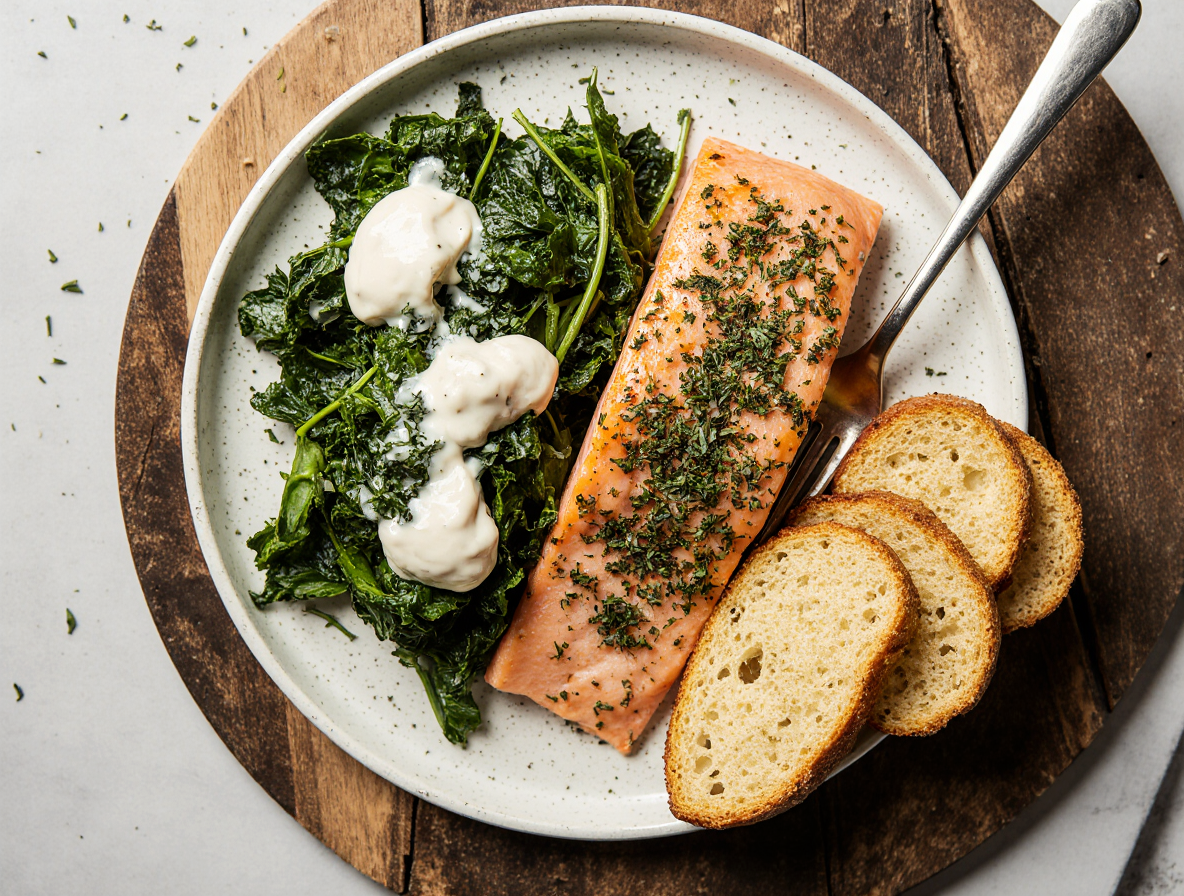How to Make Restaurant-Style Salmon Kale Caesar Salad in 30 Minutes
Did you know our salmon kale caesar salad comes together in just 35 minutes or less?
This isn’t just any salad – it’s a seriously delicious weeknight dinner that eats like a full, satisfying meal. We love how kale not only has higher nutritional value than standard romaine, but also keeps better, allowing you to prep the base ahead of time. When paired with sustainably caught salmon and a homemade Caesar dressing, this easy kale caesar salad becomes equal parts filling and satisfying – perfect for impressing dinner guests.
What makes our salmon and kale recipes special? For starters, the kale is typically on the “dirty dozen” list, so we’ll guide you through selecting the best varieties (curly kale works perfectly here). Then, we’ll show you how to achieve that restaurant-style grilled salmon caesar salad with perfectly baked fish – taking just 12-14 minutes for medium-cooked salmon, or adjusted to your preferred doneness.
Throughout this article, we’ll break down every step to create this impressive salmon cesar salad that requires minimal cook time – twenty minutes, tops. Let’s get cooking!
Choose the Right Ingredients
Selecting quality ingredients for your salmon kale caesar salad makes all the difference between a good dish and an extraordinary one. Let’s explore what matters most for each component.
Wild vs. farmed salmon: what to buy
The salmon debate often centers around wild-caught versus farm-raised options. Wild salmon generally offers leaner meat with a more complex, savory flavor and firmer texture due to their active swimming lifestyle. Furthermore, wild salmon typically has a vibrant red-orange color compared to the paler pink of farmed varieties.
If sustainability concerns you, consider that wild salmon can be sustainable when sourced from well-managed fisheries. However, farm-raised salmon helps meet growing demand while protecting remaining wild populations. For the best farmed option, look for salmon labeled free from antibiotics, chemicals, and growth hormones.
Notably, wild salmon like Sockeye is always wild-caught because its unique lifestyle can’t be replicated in farms. Meanwhile, Atlantic salmon is almost exclusively farmed.
Best kale types for Caesar salad
Lacinato kale (also called dinosaur kale or Tuscan kale) stands out as the premier choice for your salmon kale caesar salad. Its hearty, wide leaves provide ample surface area for holding creamy caesar dressing. The thinner yet sturdy leaves showcase dressings exceptionally well while offering a relatively mild taste that’s easy to enjoy raw.
Curly kale works too, though it requires more thorough massaging to break down its fibers. This crucial step transforms raw kale into silkier, tender greens that are more enjoyable to eat and easier to digest.
Since kale appears on the “dirty dozen” list of produce most likely to contain pesticide residues, purchasing organic varieties is worth the extra cost.
Optional add-ins: avocado, pine nuts, croutons
Elevate your salmon kale caesar salad with thoughtful additions:
- Avocado cubes add creamy texture that complements the dressing beautifully
- Toasted pine nuts provide aromatic crunch and can replace traditional croutons for a gluten-free option
- Homemade croutons made from leftover sourdough crisp up perfectly in an air fryer
For even more protein, consider adding crispy chickpeas as a nutritious crouton alternative. Baby cherry tomatoes introduce a burst of color and freshness that balances the rich flavors of the salmon and caesar dressing.
Prep the Components Separately
Preparing each component of your salmon kale caesar salad separately ensures every element shines in the final dish. Taking care with each step yields restaurant-quality results right at home.
How to bake salmon perfectly
For perfectly baked salmon, start by removing filets from the refrigerator about 15 minutes before cooking to reach room temperature, ensuring even cooking throughout. Pat the salmon dry with paper towels – this crucial step promotes better browning.
Place salmon skin-side down in a baking dish and drizzle with olive oil or melted butter mixed with fresh lemon juice. Season generously with salt and pepper, along with optional garlic or herbs.
Bake at 375°F (190°C) for 12-15 minutes, depending on thickness. You’ll know it’s done when it flakes easily with a fork. For precise doneness, use a thermometer – 125°F to 130°F creates moist, perfect salmon. Alternatively, air fry at 425°F for 12 minutes plus 1 minute on broil for a crispy top.
Massaging kale for better texture
Initially, this may seem unusual, yet massaging kale is non-negotiable for an excellent salad. First, remove the tough stems by sliding your hand along them or cutting them out – kale stems contain bitter compounds we don’t want. Wash thoroughly to remove any dirt or sand.
Next, tear leaves into bite-sized pieces before adding a drizzle of olive oil, a splash of lemon juice, and a pinch of salt. Subsequently, use your hands to scrunch and massage the kale between your fingers for about 2-3 minutes. You’ll notice the leaves turning glossy green and slightly reduced in volume.
This process breaks down the tough cellulose structure, making kale significantly more tender, less bitter, and easier to digest. Furthermore, properly massaged kale keeps well for 2-3 days, although don’t add dressing until serving time.
Quick Caesar dressing with or without dairy
Traditional Caesar dressing contains dairy through Parmesan cheese, nonetheless, delicious versions exist for all dietary needs. For a quick dairy-based dressing, combine mayonnaise, lemon juice, garlic, Dijon mustard, anchovy paste (or Worcestershire sauce), Parmesan, and olive oil.
Prefer dairy-free? Replace Parmesan with nutritional yeast for a cheesy flavor without the dairy. Another option uses cashews or walnuts with miso paste and nutritional yeast for a creamy plant-based alternative.
Whichever version you choose, simply add all ingredients to a bowl and whisk until combined, or blend everything in a small blender for ultra-creaminess. The dressing can be made ahead and stored in the refrigerator for up to a week, allowing flavors to meld even further.
Assemble the Salmon Kale Caesar Like a Pro
The assembly stage transforms your individually prepared components into a cohesive, restaurant-worthy salmon kale caesar salad. This final step deserves as much attention as the ingredients themselves.
Layering the salad for visual appeal
Assembly begins with a large mixing bowl where your massaged kale becomes the canvas. First, toss the kale with dressing until evenly coated. Next, incorporate half the croutons and Parmesan, saving the remainder for the final presentation. Divide the dressed kale between individual plates or bowls, placing the salmon filet prominently on top. Lastly, add the reserved croutons and cheese as garnish – these craggy edges and cheese shavings create visual interest.
Balancing textures and flavors
A standout salmon kale caesar salad requires textural contrast. The tender, massaged kale provides a sturdy yet soft base that won’t wilt like romaine. Certainly, crunchy elements remain essential – the crisp croutons or alternatives like crispy chickpeas prevent monotony. The flaky salmon adds protein-rich tenderness. Consider a final squeeze of fresh lemon or lime juice across the top to brighten all flavors.
Tips for serving warm or cold
This versatile salad shines regardless of temperature. For a hot option, assemble immediately after cooking the salmon. Alternatively, prepare and refrigerate components separately up to 3-4 days ahead for a delicious cold meal. Unless serving right away, pack dressing separately to prevent sogginess.
Expert Tips and Variations
Looking to elevate your salmon kale caesar salad? These expert modifications plus storage techniques ensure restaurant-quality results every time.
Make it a grilled salmon Caesar salad
Transform your dish by taking it outdoors! Grilled salmon delivers delicious smoky notes while cooking in just six minutes. For the ultimate experience, grill every component – from the romaine and salmon to the lemon for your dressing and bread for croutons. This technique adds remarkable depth of flavor particularly during summer months. Heat your grill pan over high heat, season salmon with salt and pepper, then grill for 5-6 minutes per side until the fish flakes easily.
How to store leftovers without sogginess
Preserve your salad’s texture by following this golden rule: only dress what you’ll eat immediately. For meal prep, keep components separated in airtight containers. Primarily, let cooked salmon cool completely before combining with greens. Pack dressing and croutons separately to prevent wilting and sogginess. According to food experts, dressed greens wilt quickly as acid breaks down their structure. Another key technique: avoid adding salt too soon, as it draws moisture from vegetables through osmosis.
Dressing swaps: tahini, pesto, or yogurt-based
Reinvent your salmon kale caesar with alternative dressings. Greek yogurt-based Caesar offers higher protein content while maintaining creamy tanginess. In essence, it substitutes traditional raw egg yolks and oil with nutritious yogurt. Additionally, tahini Caesar provides a rich plant-based option – simply blend well and adjust thickness with water. Pesto Caesar creates an aromatic variation, combining mayonnaise, Dijon, lemon juice, and basil pesto.
Conclusion
Making restaurant-quality salmon kale caesar salad at home doesn’t require professional culinary training after all. Armed with our step-by-step guide, you can create this nutritious yet indulgent meal in just 30 minutes. The combination of perfectly baked salmon, properly massaged kale, and homemade caesar dressing creates a dish that rivals any restaurant version.
Remember that quality ingredients truly make a difference. Whether you choose wild-caught or sustainably farmed salmon, paired with organic lacinato or curly kale, these foundational elements set the stage for an exceptional meal. Additionally, the simple act of massaging your kale transforms it from tough and bitter to silky and delicious—an essential step many home cooks overlook.
Thoughtful assembly also plays a crucial role in elevating this dish. Layering components strategically and adding textural elements like croutons or pine nuts creates a visually stunning presentation alongside balanced flavor profiles. Consequently, your family or dinner guests will be impressed with both the taste and appearance of your creation.
Feel free to experiment with the variations we’ve suggested. Perhaps try the grilled version during summer months or swap the traditional caesar dressing for a tahini or yogurt-based alternative. Undoubtedly, this versatile recipe adapts well to different dietary needs and personal preferences.
Most importantly, this salmon kale caesar salad works wonderfully for meal prep when components are stored separately. Though the preparation might seem involved at first, each step becomes second nature with practice. Soon, this nourishing, protein-packed meal will become a staple in your weekly rotation—proving that healthy eating can be both convenient and delicious.
FAQs
Q1. How long does it take to make a restaurant-style salmon kale Caesar salad? You can prepare this delicious salad in about 30 minutes, making it perfect for a quick weeknight dinner or an impressive meal for guests.
Q2. What type of kale works best for a Caesar salad? Lacinato kale (also known as dinosaur or Tuscan kale) is ideal for Caesar salads. Its wide leaves hold dressing well and offer a milder taste. Curly kale can also work but requires more thorough massaging.
Q3. Why should I massage the kale for my salad? Massaging kale breaks down its tough fibers, making it more tender, less bitter, and easier to digest. This process transforms raw kale into silky greens that are more enjoyable to eat.
Q4. Can I make this salad ahead of time? Yes, you can prep components separately up to 3-4 days in advance. Store the dressed kale, cooked salmon, and other ingredients in separate containers. Add dressing and assemble just before serving to prevent sogginess.
Q5. Are there dairy-free options for Caesar dressing? Absolutely! You can make a delicious dairy-free Caesar dressing by replacing Parmesan with nutritional yeast for a cheesy flavor. Another option is to use cashews or walnuts with miso paste and nutritional yeast for a creamy plant-based alternative.


